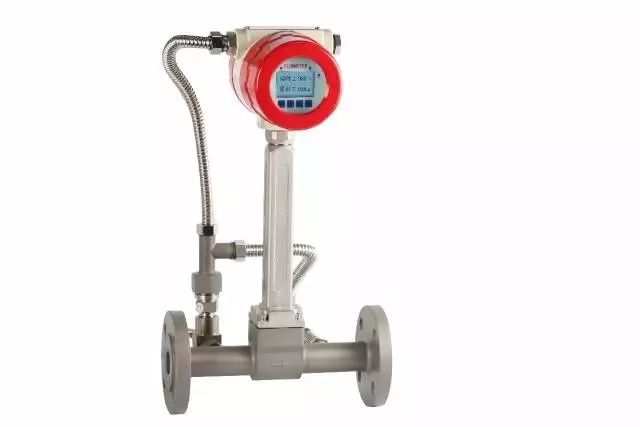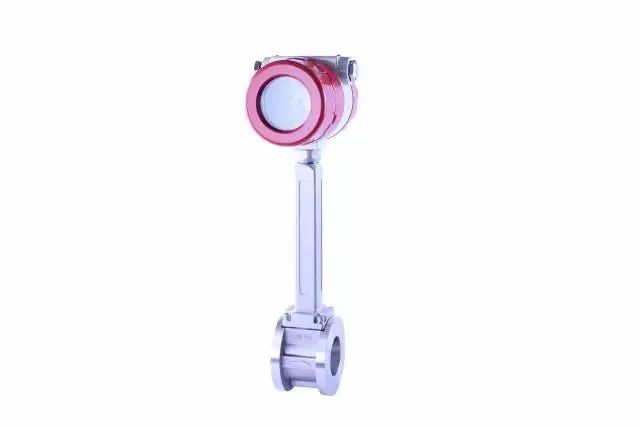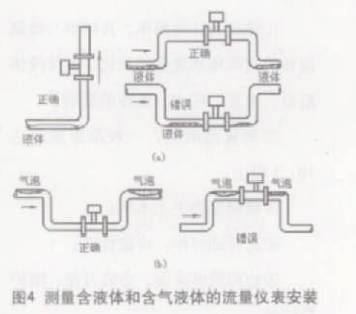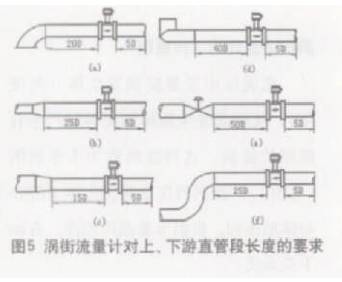The vortex flowmeter has the following features:

1 The output is pulse frequency, and its frequency is proportional to the actual volume flow of the measured fluid, and is not affected by fluid composition, density, pressure and temperature;
2 The measuring range is wide, and the general range can reach more than 10:1;
3 accuracy is the upper middle level;
4 no moving parts, high reliability;
5 The structure is simple and firm, the installation is convenient, and the maintenance cost is low;
6 Wide range of applications for liquids, gases and steam.
Application in the fieldVortex flowmeters are suitable for a wide range of fluids, but are not suitable for low Reynolds number (Re D ≤ 2 × 10 4 ) fluids. Because at low Reynolds numbers, the Strauhal number changes with the Reynolds number and the meter linearity deteriorates.
At the same time, the fluid containing solid particles can cause noise to the vortex generator, and the short fibers contained therein will change the meter coefficient if they are wound around the vortex generator.

The application of vortex flowmeters in mixed-phase fluids is as follows:
1 It can be used for gas and liquid two-phase flow with dispersed and uniform micro-bubbles, but the volumetric gas content should be less than 7% to 10%. If the volumetric gas content exceeds 2%, the meter factor should be corrected.
2 It can be used for gas-solid and liquid-solid two-phase flow containing dispersed and uniform solid particles with a content of not more than 2%.
3 can be used for two-component flow of liquid and liquid (such as oil and water) which are insoluble in each other. Pulsating and swirling flows can have a severe impact on vortex flowmeters. If the pulsation frequency coincides with the vortex frequency band, it may cause resonance, destroy normal operation and equipment, and cause the vortex signal to "Lock-in", and the signal will be fixed at a certain frequency. "Locking" is related to the pulsation amplitude, the shape of the vortex generator, and the clogging ratio.
The accuracy of the vortex flowmeter is generally between ± 0.5% R and ± 2% R for liquids and between 0.2% and 0.5% for gases ranging from ± l% R to ± 2% R. Because the meter coefficient of the vortex flowmeter is low, the frequency resolution is low, the larger the diameter, the lower the accuracy, so the gauge diameter should not be too large (below DN300).
Range width is a feature of vortex flowmeters, but the important point is the flow rate at the lower end of the range. Generally, the average liquid flow rate lower limit is 0.5 m/s, and the gas is 4 to 5 m / s. The normal flow rate of the vortex flowmeter is preferably 1/2 to 2/3 of the normal measurement range.
The biggest advantage of the vortex flowmeter is that the meter factor is not affected by the physical properties of the measured medium and can be extended to other media by a typical medium. However, due to the wide range of flow rates of liquid and gas, the frequency range is also very different. In the amplifier circuit that processes the vortex signal, the passband of the filter is different and the circuit parameters are different. Therefore, the same circuit parameter cannot be used to measure different media. In addition, the density of gas and liquid varies greatly, and the signal intensity generated by vortex separation is proportional to the density, so the signal intensity is also very different. The gain and trigger sensitivity of the liquid and gas amplifier circuits are different, the piezoelectric charge difference is large, and the parameters of the charge amplifier are also different. Even if the gas (or liquid, steam) is the same, the flow range is different, the signal intensity is different, and the circuit parameters are also changed as the medium pressure, temperature, and density are different. Therefore, a vortex flowmeter is not modified by hardware or software, and it is not feasible to change the medium or change the gauge.
Installation PrecautionsThe vortex flowmeter is a flowmeter sensitive to the distortion of the flow velocity of the pipeline, the swirling flow and the flow of the artery. Therefore, the installation conditions of the pipeline should be fully considered and strictly in accordance with the instructions for use.
Vortex flowmeters can be installed indoors or outdoors. If installed in a well, to prevent flooding, a hydrophobic sensor should be used. The sensor can be mounted horizontally, vertically or obliquely on the pipe, but to prevent interference from air bubbles and liquids when measuring liquids and gases, pay attention to the installation position (see Figure 4).

The vortex flowmeter must ensure that the upper and downstream straight sections have the necessary length (see Figure 5).

In Fig. 5, a is a 90° elbow, b is a concentric expansion tube, c is a concentric contraction full-opening valve, d is two 90° elbows in different planes, e is a semi-opening valve of the regulating valve, and f is the same plane Two 90° elbows. The connection between the sensor and the pipe is shown in Figure 6. Pay attention to the following problems when connecting to the pipe.
1 The inner diameter D of the upper and lower pipes is the same as the inner diameter D' of the sensor, and the difference satisfies the following conditions: 0.95D ≤ D' ≤ 1.1D;
2 The piping should be concentric with the sensor, and the coaxiality should be less than 0.05D';
3 The gasket can not protrude into the pipe, and its inner diameter can be 1~2mm larger than the inner diameter of the sensor;
4 If the flow check and cleaning sensor are required, a bypass pipe should be provided (see Figure 7);
5 The effect of reducing vibration on the vortex flowmeter should be considered as a prominent issue in the field installation of vortex flowmeters. First of all, when choosing the sensor installation site, try to avoid the vibration source; secondly, the flexible hose connection can be considered in the small diameter; third, the installation of the pipe support is an effective damping method.
Among many flowmeters, the purchase cost of vortex flowmeter is lower than that of mass type, electromagnetic type, volumetric type, etc., and the installation, operation and maintenance costs are lower than that of throttle type, volumetric type, turbine type, etc. A economical and practical flow meter. The vortex flowmeter has a simple and firm structure, convenient installation and maintenance, and is especially suitable for use in industrial sites such as smelters, chemical plants, and oil pipelines.
The corner cube prism is a total internal reflection prism manufactured based on the critical angle principle. It is not affected by the incident angle and reflects the incident light by 180 °. In other words, for any incident light entering the clear aperture, it will be efficiently reflected back in the original direction. Because of the special performance of the corner cube, it is often used in measurement systems, optical signal processing and laser interferometers.
The corner cube prism is a glass element used for retroreflecting. It retroreflects the incident beam with three 90° angles. The error of these glass angles must be within a few seconds of accuracy, but the incident surface can have an error of more than 5" without significant impact on the performance of the corner cube.

Leica Prism,Cube Reflector Prism,Corner Cube Reflector,Corner Cube Reflector Prism
Bohr Optics Co.,Ltd , https://www.bohr-optics.com
